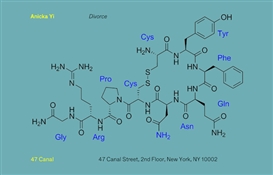Anicka Yi’s Botanical Existentialism
Through biology, scent, and AI, Anicka Yi questions evolution, decay, and the future of art beyond human authorship
Sierrah Floyd / MutualArt
14 Oct, 2025
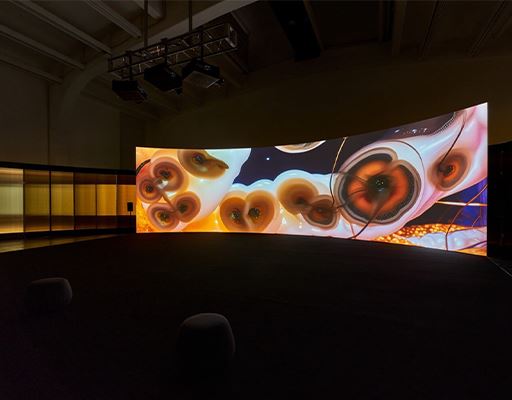
Anicka Yi’s Beijing retrospective places the biosphere and the technosphere in a blended perspective, opening questions about generative AI and the existence of immortal arts. Yi has stated, “We’re at this critical razor’s edge … where we can either annihilate ourselves with our fear of technology or try to endure and prosper.”
After her own words, “we may be in the midst of another evolution, but it is happening inside this one,” There Exists Another Evolution, But in This One, co-curated by Peter Eleey, posits how Yi engages with bio matter and “non-human” entities to charge technologically centered works.
Yi began frying plants in 2009, and her work has since followed themes of decay, decentralization of the human, and the emergence of technologically generative intelligence. She challenges art’s marketability in her works, which once experienced seem “uncollectible” to the average buyer. Seeing decay at play in real time in Yi’s bacteria infested containers, and collaborating on unpleasant fragrances, her focus clearly is centered on impact rather than material gain.
On view at the UCCA Center for Contemporary Art, about forty works filled gallery walls turned chromatic tunnels and futuristic, dynamic, deep hued rooms. The atmosphere of the Center’s largest open space gallery garnered the viewer to think about what might be growing underneath. Yi emphasizes that non-human organisms such as algae, fungi, and machines, are commendable living things. Most of her work ventures into non-human living objects being considered as important aspects of everyday life. She sees them as othered – a category of grotesque creatures which humans need to survive but are not necessarily praised. The main pinpoints of the work delve into technology as a counterpart, using scent to stabilize the viewer, and connecting the thread between biomass and technomass.
Scent ties into Yi’s practice as she feels it is tethered to otherness. Being Korean American, she could recall the smell of how Asian cooking was met with disdain as a child. Digging deeper into that thread, in Walking on Two Paths at Once, 2023, a fragrance collaboration with master French perfumer Barnabé Fillion, visitors are engulfed by a damp, metallic, floral, and umami scent, evoking questions like “Does light have scent?” or “Can a scent hologram exist?”
In Tempura Fried Flowers, 2014-ongoing, Yi dips flora in cooking oil and batter, an act that may strike the viewer as unsettling, showing how humans accelerate nature’s cycles. A necessary, cruel and experimental take which recalls the Anthropocene – although not Yi’s intention – as humans distort natural balance.
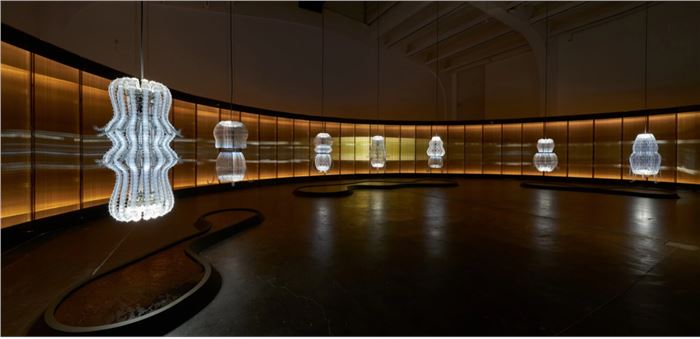
Other works bridge biology and machinery. The Radiolaria series, 2023–24, inspired by microscopic organisms that regulate the planet’s oxygen and carbon cycles, features large, jellyfish-like sculptures woven from optical fiber, silicone, and light. These “biologized machines” pulse and breathe in dim light, suggesting a living system of their own. The rhythmic motion hints at a shared language between organic and synthetic life – one the viewer can sense but not decipher.
Yi’s less mechanical works merge the industrial and the organic. Is Civilization Worth It?, 2022, contains a blend of pathogenic bacteria which activates fungal networks of body eating and human eating organisms, encased in a lightbox. As time progresses, the bacterial culture germinates into vibrant sunny hues. In Plastiglomarate, 2024, part of her “Pre-Cambion” series, Yi provides a fossil of trinkets of early evolution for the Anthropocene. A concave metal impression of objects familiar to our contemporary conditions, made immortal via mortal hands, not time.
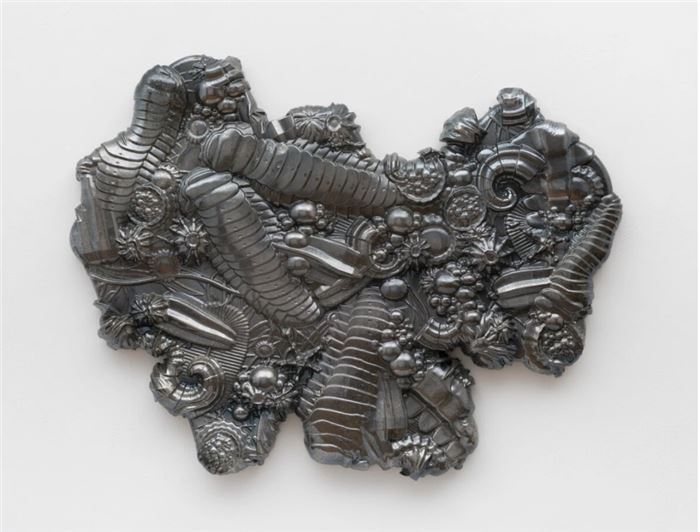
The multimedia sculpture Feeling is a Skill, 2015, combines kombucha and sterile laboratory metal stands. Yi dehydrates its bulbous culture into a flat “leather”, masking as vellum, aiming to challenge materiality. This organic alternative supports a feminine materiality that is neither heavy nor rigid. Mounted on laboratory metal stands, the piece balances the sterile with its more flowing, bellowing counterpart.
In Exaggerate the Little Deaths, 2022, and The Possibility of an Island III, 2012, Yi examines how humans perceive the body through biology and the senses. She places pores and feathers on synthetic flowers or submerges contact lenses in saline to question Western ocular centrism – the privileging of sight over touch, smell, and sensation. Her intention is to decenter the eye and invite viewers to experience through other senses.
And finally, the most interesting portion of the show, and telling of her artistic plans, Each Branch of Coral Holds Up the Light of the Moon, 2024, reflects Yi’s meditation on mortality and technological legacy. She describes it as preparation for “when her body has reached its mortal end.” Additionally, she shares that humans have an intrinsic need to be immortalized through things, memory, and now, AI. “There is an impulse for us as a civilization to want to preserve a memory of an idea through new emergent tech… it’s a motivation I understand, will I or my studio be haunting the world in the future? We will be creating our own.”
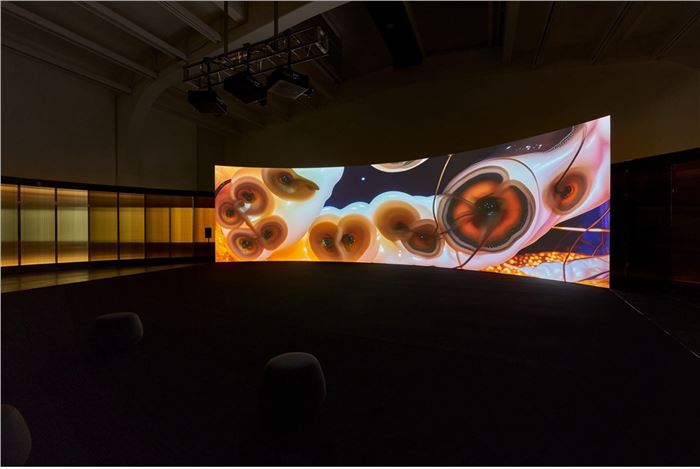
Yi extends these ideas in Quantum Foam Paintings, 2024, a series of algorithmically generated videos that simulate the organic shapes Yi describes as unwelcome. She wonders in these pieces, how can machine intelligence lead to further evolution in painting and has trained the learning systems to recall natural forms like blood cells, algae, clumps, ocean flows. Technology and decay seem to always mesh together in these works.
The show, for me, brings up many questions, and many answers. Nonhuman organisms will not cease to exist. We need them, and they need us. Such is the cycle of life. I wonder if the necessity for humans to recognize their importance in that cycle is too simple, and if it creates dangerous structures around how – human to human – the value of life is being credited or discredited. To equalize one thing, essentially devalues another. Or, such is the cycle of evolution, that once man becomes too evolved, it will dismantle itself.
Outside of the organic, we have the human and the non-organic, where I see multitudes of possible futures. I feel the show is more about the future of the arts and how artists will connect, create, and be remembered through, with, and by their work.
If artists are to continue down this path of creating to be computerized, where will the authenticity of art end up at in not even ten years? I wonder what the direction of the show was, and its overall purpose. To give a premonition? To help us cope with the end of an era? To conjure up a sense of doom? On the negative end of the spectrum, you might end up here – wondering what exactly, or where, art will become as more and more industries, including the arts, work arm in arm with technology.
According to Yi, machines will not need art. Does fine art then become a vacuum? Does it become a game? An endless black hole? What, then, becomes the point if artworks cease to exist in the physical realm and only exist as a projection of what once was, confined to a screen. Will physical art cease to be symbolic?
I wonder about art’s place in the world and how it is rebirthing itself at this moment in history. Or, viewing Yi’s exhibition as a sounding alarm, as artists are encroaching on an enmeshment of creation with machines in a more collaborative sense, where they co-author or give agency in its entirety to autogenerated intelligence. If we are to accept technology as another portion of the creative thought process, Yi’s point about machines becoming or being thought of as equals to humans may not be so far in the future as we would like it to be.
There Exists Another Evolution, But In This One was on view at the UCCA Center for Contemporary Art from March 22, 2025 through June 15, 2025.
For more on auctions, exhibitions, and current trends, visit our Magazine Page

 ARTISTS
ARTISTS







